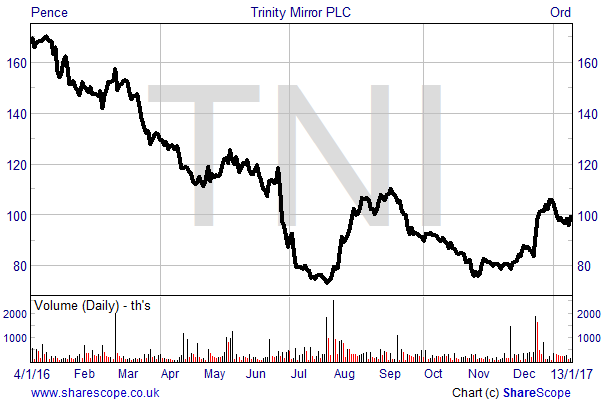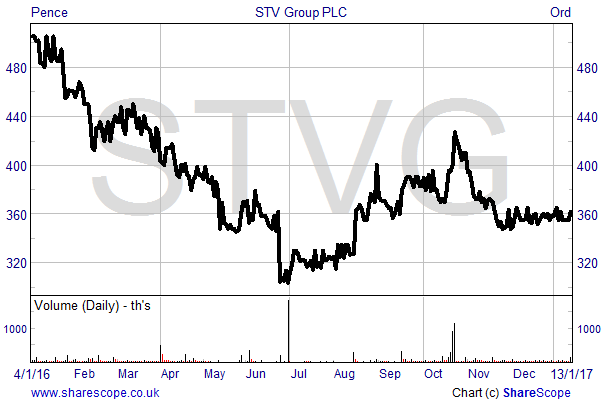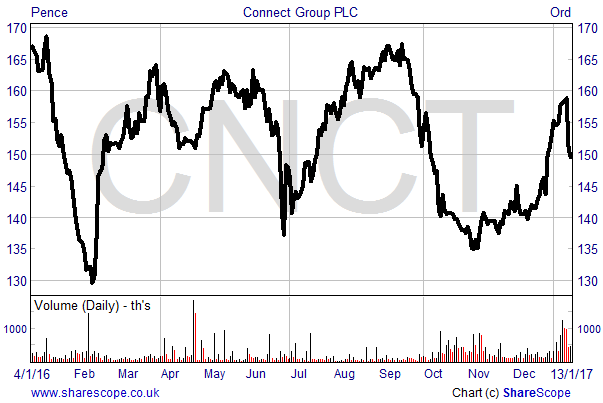Bargains still to be had in the small cap markets

As discussed in my article for January’s edition of Master Investor Magazine, 2016 was a great year for small cap shares. The AIM All-Share rose by an impressive 14.3%, the FTSE Small Cap Index surged by 11% and dozens of individual stocks grew in value by more than 100%. Three stocks even finished the year up by an eye watering 1,000% or more!
With some small cap indices reaching all-time highs and a raft of shares now hitting toppy valuations, it’s becoming increasingly difficult for investors to pick out value stocks. But, as ever, there are still a number of companies trading at bargain prices. Here follows three companies listed on the FTSE Small Cap Index which I believe offer good value.
Trinity Mirror
I last covered newspaper owner Trinity Mirror (LON:TNI) on the Master Investor blog HERE in August last year. Since then the shares have risen by a decent 10%, with a 2.1p interim dividend taking the total return to 12.3%. Nevertheless, the company remains one of the lowest valued on the whole of the London markets. To re-cap, here’s why.
– Huge pension deficit. Trinity’s pension deficit, at £426 million, is even larger than Bob Maxwell’s stomach. A related funding plan is sucking cash out of the business.
– Phone hacking costs. For its part in the phone hacking scandal Trinity has made a total provision of £52.5 million to cover damages and victims’ legal costs. Damages for over 80% of claims have now been settled but the market remains wary of further cost increases.
– Decline in the print industry. Trinity has struggled to adapt its business model to take advantage of the shift from print to digital media/advertising over the past decade.
Despite these issues the company does have certain attractions.
Following the 2015 acquisition of Local World Trinity is the largest regional news publisher in the UK, with substantial scale synergies set to be enjoyed as the two businesses become fully integrated in the coming months. Digital revenues are now starting to show good momentum across the business and operational cashflow remains very strong across the group, even after considering the large payments into the pension scheme.
A trading update from the company in mid-December impressed the markets, with Trinity announcing that its overall performance for 2016 will be marginally ahead of expectations. Perhaps the main highlight was that net debt is forecast to be £35 million by the year end, down significantly from £92.9 million 12 months earlier. This was achieved despite an 8% fall in like-for-like revenues in the fourth quarter, as sales from print related sources continued to decline.
The latest news from the company came in a brief statement which confirmed media reports that it is in early discussions with Northern & Shell, owner of the Daily Express, the Star and OK! magazine, with a view to taking a minority interest in a new company containing certain Northern & Shell assets. While the facts remain unclear, rumours are that, at a minimum, the two publishers are looking to merge back office and sales operations in order to make substantial cost savings.
While the risks here are clear I believe that the shares are worth a punt on valuation grounds.
Shares in Trinity Mirror have had a shaky start to 2017, falling by almost 6.4% to 96.25p in just nine sessions of trading. Capitalised at £270 million the company now trades on a multiple of just 2.7 times consensus forecasts for the financial year just finished. In the current year the multiple remains around the same as a further expected decline in revenues is offset by synergies enjoyed from the full integration of Local World.
If last year’s total dividend payment of 5.15p is maintained then the yield on offer is a healthy 5.35% – although it should be modestly higher given that trading has been slightly better than expected. Broker Numis maintains its 210p target for the shares, which implies 118% upside from current levels. So for the risk tolerant investor, Trinity Mirror could turn out to be a smashing investment.

STV Group
Also operating in the media sector, but this time in television, is STV Group (LON:STVG), a broadcasting and production company which owns the Channel 3 licences for North and Central Scotland. Recent years, under the stewardship of CEO Rob Woodward, have seen the company turned around from a bloated, debt ridden conglomerate to a streamlined, focussed and highly profitable and cash generative business.
STV currently operates via two divisions. The Consumer business, which makes up c.93% of revenues, delivers the full Channel 3 programme schedule via digital terrestrial, cable and satellite television in Scotland and on digital channels via the STV Player. The majority of revenues are derived from advertising, both from “national” sales via ITV’s sales force and from its own regional Scottish airtime slots. Secondly, STV Productions creates and produces programmes for broadcasters in the UK and overseas, including the BBC, ITV and Channel 5, including my particular favourite, the gameshow, Catchphrase.
As a result of the turnaround in the business STV has achieved a lot over the past few years. Underlying earnings grew from 13.7p in 2009 to 39.9p in 2015 and net debt, which hit a peak of £189.4 million in June 2007 had been reduced to just £29.1 million by June last year. A return to the dividend list was announced in 2014 as a result of the debt reduction and consistently strong operational cash flow.
However, like Trinity above, STV also has problems with its pension, with the deficit as at 30th November last year standing at £129.9 million – not too far short of the company’s current market cap. To fund the gap an 11 year recovery plan has recently been agreed, which will see annual payments of £8.6 million, rising by 2% per annum.
Time to tune in to the shares?
Since hitting an eight year high of 515p on New Year’s Eve 2015 shares in STV have slipped back to the current 355p – a fall of 31%. While the 2015 results were hit by the Productions business failing to hit its targets I believe that the fall looks harsh in the context of steady underlying profit and earnings growth being posted.
We should see results for 2016 from the company in late February/early March, with the markets currently expecting earnings of around 39.4p for the year. That puts the shares on an undemanding looking multiple of 9 times, which falls to 8.5 in the current year on the back of forecasts for 41.4p of earnings.
In contrast, peer ITV (which has long been rumoured to be interested in making a bid for STV) trades on a multiple of 12.8 times. Applying that multiple to STV, which does not seem unreasonable given the strength of the business, would suggest an end 2017 target price of 530p, implying 49% upside. The house broker, Peel Hunt, has a more modest 460p target price for the shares. A decent dividend yield of 4.1% is also on offer for the current year.

Connect Group
Finally, Connect Group (LON:CNCT) is the company previously known as Smith’s News, having been created in 2006 following its demerger from newsagents WH Smith. While the roots of the business go back to 1790, when the firm first started delivering newspapers, it changed its name in 2014 to reflect a more broad focus on the distribution industry.
As of today Connect is a £1.9 billion revenue business and operates across five divisions. The core News Distribution division is still the core of the business, having a 55% market share in the UK, making up 76% of turnover in the last financial year and 59% of operating profits. But with the print industry seeing a structural decline Connect has a medium-term strategy focussed on delivering 50% of profits from outside newspaper and magazine wholesaling.
To that end Connect has moved into a number of other areas including the distribution of education & care consumables, delivering print publications to airlines and providing other inflight services, and book delivery. In December 2014 Connect further expanded its operations by acquiring Tufnells Parcels, a next day B2B delivery provider for mixed parcel freight consignments.
While trading has been challenging over the past few years Connect has consistently put in a steady financial performance, with underlying earnings for the five years between 2012 and 2016 inclusive ranging from 19.7p to 21.7p per share. However, the real highlight of Connect’s accounts is its superb free cash flow. In the last financial year this stood at £49.6 million, equating to a free cash flow yield of 13.4%.
There are some balance sheet concerns however, with a current ratio of just 0.68 times – a figure below 1 suggests the company may struggle to pay its bills on time. Net debt stood at £141.7 million as at 31st August 2016, but interest payments were comfortable, being covered almost 10 times by underlying operating profits. In contrast to Trinity Mirror, the pension deficit of £21.2 million is modest, with annual contributions comfortably covered by cash flow.
Will the shares deliver?
Connect Group shares have traded steadily over the past two years, having been priced in a range of between 140p and 160p for much of that time. The current price of 149.5p values the business at £370 million and puts the shares on a multiple of just 7.5 times market consensus forecasts for the current financial year (to August 2017). There are big income attractions here, with the historic dividend yield being 6.35%.
With the valuation being so low I also see room for capital appreciation should Connect continue to deliver consistent results. Analysts at FinnCap have a 196p target price for the shares, implying 31% upside from the current price. Ahead of a trading update scheduled for 26th January, I believe that, while clearly not a growth stock, Connect Group does offer good value.

Comments (0)